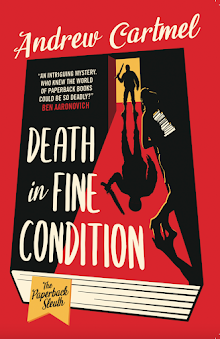 It's kind of fun to be out and about in London on a windy spring day, standing at a bus stop in Putney, post code SW15, reading an Agatha Christie and discovering that the crazed killer in the story is posting his taunting letters from — yes, "Putney, SW15."
It's kind of fun to be out and about in London on a windy spring day, standing at a bus stop in Putney, post code SW15, reading an Agatha Christie and discovering that the crazed killer in the story is posting his taunting letters from — yes, "Putney, SW15."The taunting letters in question are addressed to Hercule Poirot. The ABC Murders is Poirot's 13th adventure, and it really is outstanding. The previous ones I've read were Cards on the Table (the 15th) and The Murder of Roger Ackroyd (the 4th).
 Cards on the Table was okay. Roger Ackroyd had a devastatingly brilliant twist, but was rather creakily written.
Cards on the Table was okay. Roger Ackroyd had a devastatingly brilliant twist, but was rather creakily written.The ABC Murders, however is superb. By now both Christie and her detective hero are increasingly concerned with the characters involved in the story — "More and more I interest myself in the human developments which arise," says Poirot.
 Christie's characters are distinct, varied and very concisely evoked through dialogue. Her dialogue is variable but is often superb. No wonder she was such a natural and brilliant playwright.
Christie's characters are distinct, varied and very concisely evoked through dialogue. Her dialogue is variable but is often superb. No wonder she was such a natural and brilliant playwright.Indeed, her colloquial speech can be as convincing as Pinter's. The working class voices in her work are surprisingly well caught. It's odd that her more affluent and upper class characters come across as rather artificial, when this was the milieu Christie was born into...
 We even see improvement in the dialogue of Poirot — which normally tends to be a string of mannerisms ("little grey cells") and fake foreignness ("Une bonne idée"). But in The ABC Murders he accurately and amusingly describes one of the victims as a "pretty fluffy fool."
We even see improvement in the dialogue of Poirot — which normally tends to be a string of mannerisms ("little grey cells") and fake foreignness ("Une bonne idée"). But in The ABC Murders he accurately and amusingly describes one of the victims as a "pretty fluffy fool." (Christie is always good at depicting vapid, vain, foolish or shallow women.)
 But naturally in Agatha Christie, and in murder mysteries generally, plot is king. And the plot here is staggeringly good.
But naturally in Agatha Christie, and in murder mysteries generally, plot is king. And the plot here is staggeringly good.For a start, this a complete departure for Poirot. Instead of dealing with a conventional murder, he is pitted against a serial killer — "the 'chain' or 'series' type of murder," as it is described.
He remarks to Captain Hastings (his Dr Watson), "this is the first crime of this kind that you and I have worked on... cold-blooded, impersonal murder."

The serial killer, who begins to emerge in the story as a highly organised madman, is choosing his victims — and their location — alphabetically. Hence the title, which also alludes to the ABC Railway Guide which was a major feature of British life at the time.
(And which is why so many covers of this book feature trains — rather misleadingly, since they play no part in the story. Unlike Murder on the Orient Express.)

The manhunt for this dangerous lunatic makes for a very compelling read. But what really distinguishes this book is the utterly unexpected ending. I sincerely doubt you will guess the final revelation.
I sure as hell didn't.
 At this point in her distinguished career Agatha Christie was a writer in full and confident command of her craft. So much so that she can pause for a mischievous discussion of murder mystery cliches à la John Dickson Carr, and even audaciously include Poirot's description of his ideal whodunit —
At this point in her distinguished career Agatha Christie was a writer in full and confident command of her craft. So much so that she can pause for a mischievous discussion of murder mystery cliches à la John Dickson Carr, and even audaciously include Poirot's description of his ideal whodunit — He murmurs, "four people sit down to play bridge and one, the odd man out, sits in a chair by the fire. At the end of the evening the man by the fire is found dead. One of the four... has gone over and killed him, and intent on the play of the hand, the other three have not noticed... Which of the four was it?"
He murmurs, "four people sit down to play bridge and one, the odd man out, sits in a chair by the fire. At the end of the evening the man by the fire is found dead. One of the four... has gone over and killed him, and intent on the play of the hand, the other three have not noticed... Which of the four was it?"This is, of course, the plot for Cards on the Table, which Christie would publish a few months later.
Talk about cheeky...
(Image credits: the covers are from Good Reads, where I tried to avoid ones where the railway motif is rather done to death.)




No comments:
Post a Comment